Last Updated on March 22, 2024 by Masha Eretnova
Acrylic paint is a versatile type of paint that can be used on many surfaces, so it’s not surprising how often acrylic brushes are used.
Acrylic paints become sticky if left in contact with a brush for too long.
To avoid this problem and keep your brushes lasting longer, you should clean acrylic paint brushes properly as you work and after the painting is done!
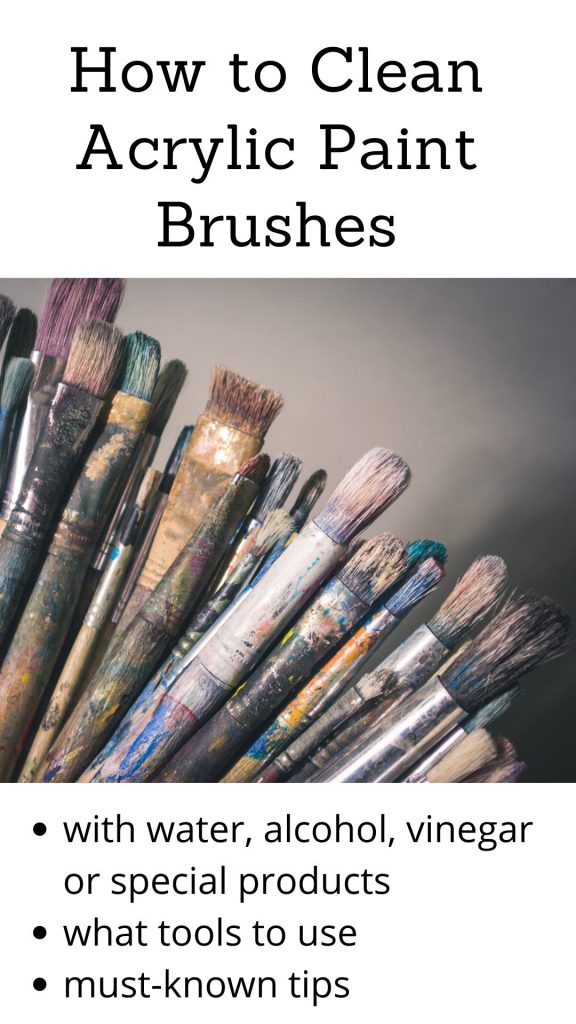
As I’m painting with acrylics since 2020, I had horribly dried brushes and gradually learned to be disciplined about cleaning them. I share my way of keeping brushes clean and some alternative solutions.
Table of Contents
This post contains affiliate links. It means no extra cost for you but a tiny commission for me to support my hobby blog. Thank you!
Keeping brushes clean as you work
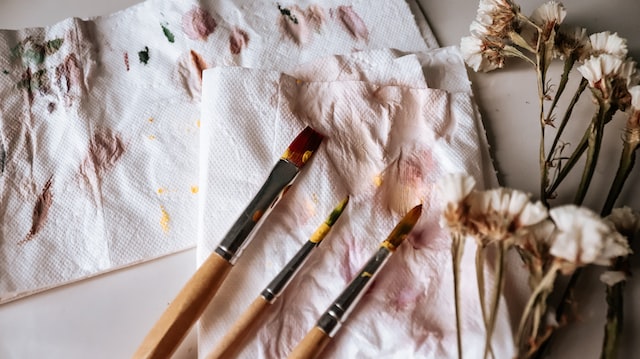
To keep my brushes clean when I’m switching in between colors painting, I use a few of the same brushes (I keep a few flats and round brushes ready) and I use 2 jars of water while painting.
The first glass jar will be the one you use the most, to quickly rinse colors in between.
The second jar – with clean water – is a safe clean space to keep your brushes clean, wet, and ready to paint.
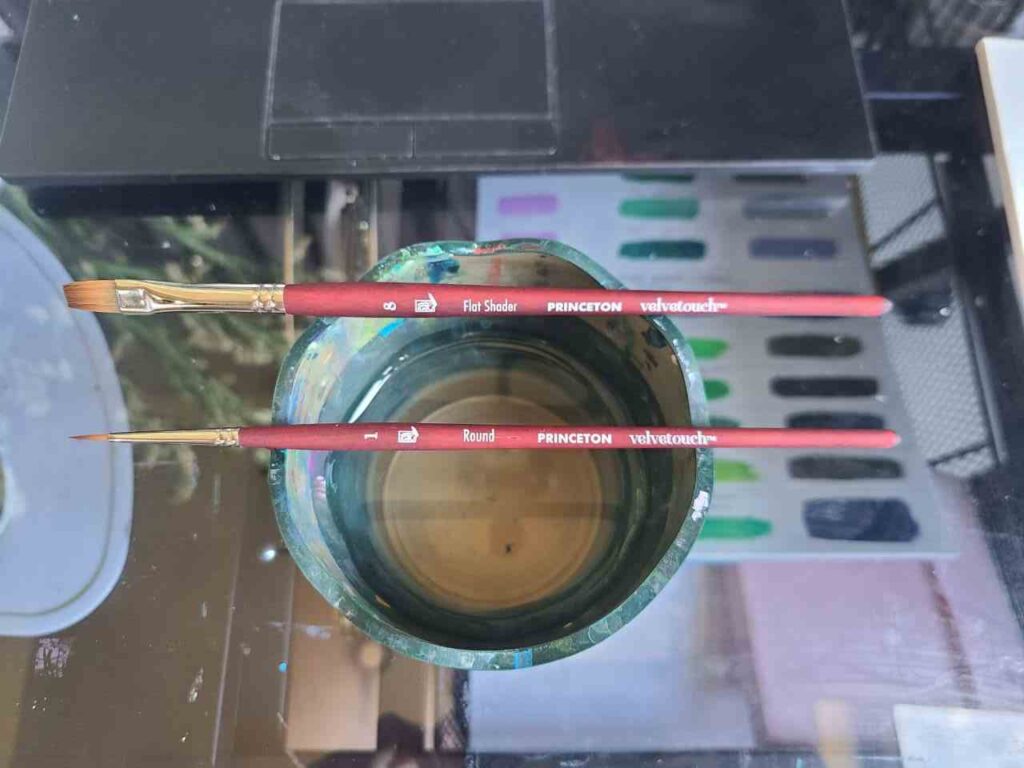
Also, I do not dip more than 1/3 of the brush in color otherwise it will take a long time to wash off the bristles.
You should keep some paper towels to soak the remaining water from brushes if you’re painting with acrylics or mixing colors. I squeeze all the excess or lightly tap the towel.
WARNING: If your brush starts losing bristles while cleaning or painting, you need to replace it. Always TRY an aggressive cleaning method on one brush before you clean all your brushes (especially expensive ones).
Cleaning brushes after painting
The rule is to keep your brushes in clean water while you’re painting and clean them gently but thoroughly right after each painting session with acrylic paint.
What bristles you have is a determinant factor for choosing how to clean your brush! Synthetic brushes cannot withstand harsh solvents!
For natural brushes and dried paintbrushes, you can use alcohol, acetone, hand sanitizer, and even white vinegar mixed with water.
A poor-quality brush will leave brush strokes and marks and not last as long as you would like.
You may be surprised how much paint brushes hold, especially round brushes! So even if it seems like it will be fine, please, do a final rinse quickly.
The cheapest and easiest way is to clean acrylic paint brushes with water and soap. Yes, that’s it.
- Squeeze the water out of your brush and massage in a circular motion with light pressure. If you are using brushes made from natural hair, make sure to avoid getting any soap on them.
- Rinse until all the paint is removed (you might need more than one rinse) and wash a brush gently.
Always keep a paper towel to dry the brushes or to remove excess paint.
Read also: How to Use Acrylic Paint: 3 Easy Steps To Paint With Acrylics On Canvas
What Can We Use To Clean Acrylic Paintbrushes? Products & Tools
Except for products we have at home and water or soap, there are some special cleaners for paintbrushes.
In fact, for acrylic paint water and soap may not be enough for proper brush cleaning – many other products out there are specialized for this.
I’m sharing links to the Blick online store, as it is often way cheaper than Amazon.
The Best Acrylic Brush Cleaners are Winsor & Newton Brush Cleaner and The Masters Brush Cleaner.
- WINSOR & NEWTON Brush Cleaner and Restorer – solution.
- The Masters Brush Cleaner and Preserver – more like soap. Cheaper and more popular.
The main difference and advantage of using a professional cleaner are that normally they are not just cleaner, but a restorer of the brush at the same time.
It means they cause no damage to the brush head or loss of fibers.
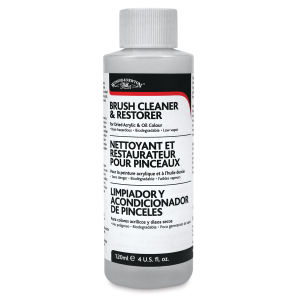
Winsor & Newton Brush Cleaner and Restorer works for natural or synthetic brushes, oils and acrylics.
Dried acrylics can take several hours to soften.
This solution may be more expensive than The Maters cleaner.
Do not use with plastic elements – they can be destroyed by this solution.
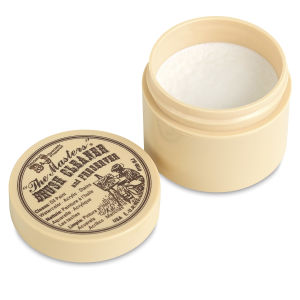
The Masters Brush Cleaner and Preserver is a good choice for those who don’t want to just use dish soap or brush cleaner from the dollar store.
It works for varnishes, acrylic paint, oil paint, and watercolor – it is a universal cleaning tool for artists.
It will help with cleaning dried paint off the brush.
You are looking for a more eco-friendly option – Da Vinci All Natural Brush Soap with Conditioner is a 100% vegetable-based soap for brushes.
Brush Cleaning tools
You can help yourself not only with cleaning products but with cleaning tools, like PAINT PUCK Paint Brush Cleaner Set – they are silicone cups with nubs that help deep clean the brushes. Suitable for all kinds of brushes.

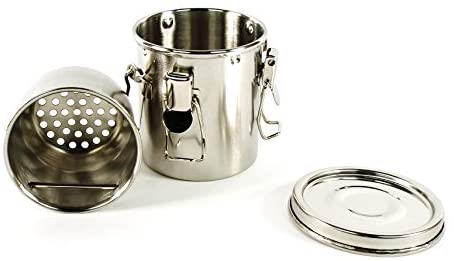
In needs to be placed into a jar, which makes it a handful and inconvenient at the same time.
Another cleaning tool is a Guerrilla Stainless Steel Brush Washer. I think it is a great tool, as I hate washing acrylic paint brushes in the sink or even in a pot – paint sticks to everything.
If you have a white sink you may find it less white after a couple of cleaning sessions.
You can even have 2-3 washers: one with clean water, one with warm soapy water, and one for dirty water.
You can also take this washer with you if you’re painting outside. It is also eco-friendly, as cleaning brushes under running water is bad for the fishies and for plumbing.
Can you clean acrylic paint brushes in the sink?
Yes and no.
Pouring acrylic paint through the drain is not a good idea and harms the environment and your pipes, it is best to wipe off all excess paint from acrylic paint brushes before you wash them with soap and water.
Then some artists collect that water in a bigger bucket and add cat litter that soaks it up. Or you can also reuse that water to clean brushes again.
At the same time, it is not illegal* to clean them in the sink and many people and art schools do that until today.
*There are countries where you cannot wash paintbrushes or rollers used for house paints outdoors, like Australia.
Alternative ways to clean acrylic paint brushes
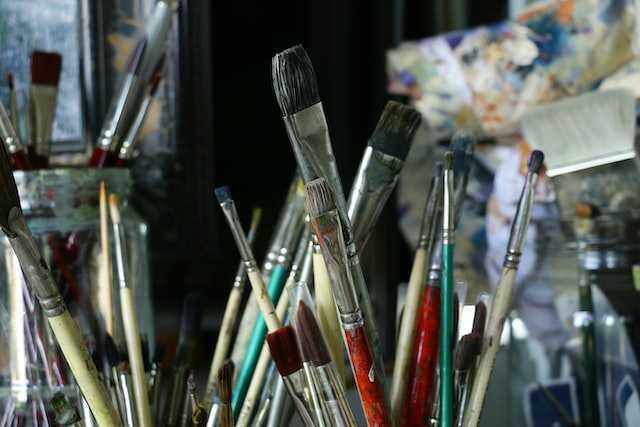
Vinegar
White Vinegar is a natural cleaner and natural degreaser, and it can also soften dried and hardened paintbrushes.
- Rinse the brush with water to remove any leftover paint.
- Pour a small amount of white vinegar and rub it into the bristles in a circular motion, until most of the paint is dissolved (might need more than one rinse).
- * If you’re cleaning a brush with dried paint on it, try boiling vinegar with bristles dipped in it into a pan. Use an old pan, that you will not use for cooking later! Remove the brush from the vinegar every 15 to 20 seconds to check on how the bristles are cleaning up.
- Rinse thoroughly with water.
Rubbing alcohol – For Dried Paint on Brushes
It is not recommended to use alcohol (rubbing alcohol, isopropyl alcohol, ethyl alcohol) or acetone solution for regular cleaning brushes with acrylic paint or other water-based paint and synthetic bristles.
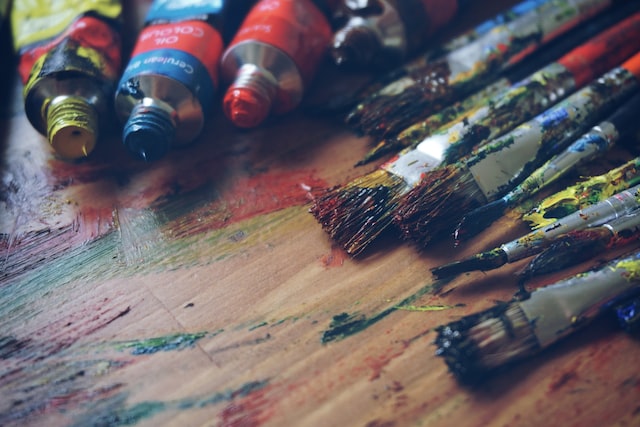
Alcohol will dry out the bristles and make them brittle, so be careful cleaning paint brushes with acetone or alcohol, especially synthetic ones.
But if you have some old brushes that need to be restored, you can use 70-90% Isopropyl alcohol to soak them for no longer than 5 minutes.
If you were using alcohol, please take care of your brushes after. Use any Preserver to restore the brush’s durability and finish cleaning.
Read also: How to Rehydrate Acrylic Paint: 14 Good & Bad Ways To Soften Acrylics
How to clean acrylic paint brushes after varnishing

Varnishing is a protection for your painting.
Always use a separate paintbrush for varnishes or protective finishes. This brush should be labeled and stored bristles up, and you need to clean it immediately after varnishing.
Varnish has a different composition from paint. You can use mineral spirits to remove solvent-based varnishes from the acrylic paint brush or soapy water for water-based varnishes.
Always wear a pair of cloves working with solvents and varnishes.
14 Cleaning Tips From An Artist
- Clean brushes as soon as you can to avoid the paint drying on them.
- Avoid using alcohol or thinner for acrylic paints, they will dry out and break off bristles prematurely.
- If you are not sure how to clean your brush then use a cheap soap (such as dishwashing liquid). Acrylic paint is water-soluble so it is easy to clean.
- For natural hair brushes, make sure you use a soap or brush cleaner specially designed for their type of bristles.
- If using dishwashing liquid then rinse thoroughly with water and leave them to dry vertically before storing in a paper towel wrapped around the handle.
- Make sure your paintbrush always stays wet when not in use while painting. This will prevent the paint from drying out and breaking off bristles prematurely. It is best to store them in a jar so they are also protected against dust, dirt, or other airborne particles that may settle on your brush while it’s not being used.
- Store brushes vertically with as little contact between their bristles as possible for optimal longevity.
- Make sure that you are using your brushes correctly and how they should be used for the best results. For instance, natural hair brushes need to be cleaned with a soap designed especially for them – not dishwashing liquid or other household cleaners.
- Avoid twisting bristles while cleaning as this may damage them, don’t scrub too hard as this may also damage the bristles.
- Never leave the ferrule of the brush, the handle of the brush, and the brush hairs too long into the water or whatever solution to avoid rust, deterioration, and loosening.
- Don’t leave too much paint on brushes.
- Condition brushes regularly: Use a brush conditioner. Your brushes will keep more color if you condition them on a regular basis. Brushes can be kept soft with regular hair conditioners, but numerous art supply companies have developed their own brush soaps to condition, maintain, and restore bristles.
- Always use a brush with care and make sure you don’t bend them out of shape or scrub too hard to avoid damaging their bristles. Brushes are costly so keep that in mind when using it!
- Try using a basket and not flush dirty water to stay more eco-friendly.
- A good way to store paintbrushes is bristles up.
Keep learning about brush techniques and characteristics in my next posts:
- 18 Tips To Avoid Brush Strokes In Acrylic Painting
- The Best Brush for Acrylic Paint on Canvas in 2021
- 15 Tested Chalk Paint Brushes & Best Brush for Chalk Paint in 2023
- 13 Best Miniature Paint Brushes For Wargames Models [Brushes under $20 included]
- 19 Best Brushes for Gouache Reviewed by Artist [Ultimate Brush Guide]
To Sum Up
To make cleaning acrylic brushes easy as a breeze, keep them clean while painting and rinse with water right after you are done painting for today.
It will ultimately save you time and money on new brushes! And it is really THAT easy!
Well, I know very well that we do forget that, I have brushes I ruined because I forgot to clean them after varnishing, but dried paint still can be salvaged.
To remove particularly stubborn paint, only in cases of emergency, you can use harsh liquids containing mineral spirits or alcohol.
But let’s hope it won’t come down to that!

Masha Eretnova, born in 1991, is a Buenos Aires-based certified teacher, artist, and member of the Professional Artist Association with 20+ years of personal painting journey.
She started painting and drawing very early and is now an international abstract artist and educator passionate about acrylic painting, gouache, and crafts.
Her works are part of international exhibitions and contests, including ArtlyMix (Brazil), Al-Tiba 9 (Spain), Exhibizone (Canada), Italy, and many more.
Besides her artistic pursuits, Masha holds a post-grad diploma in Teaching Film Photography and 2 music school diplomas: piano and opera singing.
